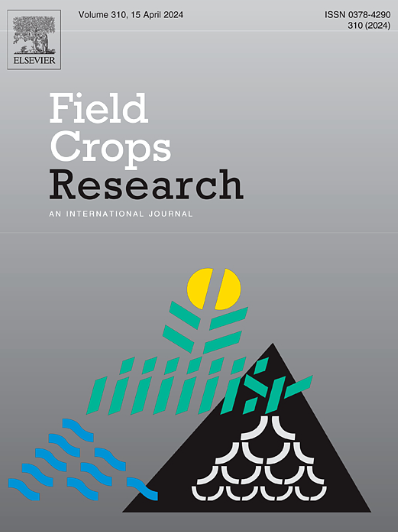华北平原和西北地区不同管理措施对玉米产量和水分利用效率影响的差异量化:meta分析
IF 5.6
1区 农林科学
Q1 AGRONOMY
引用次数: 0
摘要
华北平原和西北地区都是重要的玉米产区;但它们的管理实践,如水管理、氮管理、覆盖和秸秆还田,差异很大。在西北地区,玉米生产主要依赖季节性降水,而西北地区则严重依赖灌溉。由于地理位置、气候、土壤性质和人为因素的差异,量化这些管理措施对NCP和NW玉米产量和水分利用效率(WUE)影响的差异具有挑战性。本研究的目的是量化不同管理措施对玉米产量和水分利用效率的影响差异,并评估这些管理措施对玉米产量和水分利用效率的相对重要性。本研究对来自NCP和NW的1058个数据集进行了综合荟萃分析,深入了解管理措施对玉米产量和水分利用效率的影响差异。此外,采用随机森林分析量化了不同管理措施对两个地区玉米产量和水分利用效率的重要性。结果与结论由于西北西北地区的降水量、土壤有机碳和全氮含量较低,管理措施对玉米产量和水分利用效率的影响大于西北西北地区。其中,氮肥管理对产量和水分利用效率的影响最为显著,其次是覆盖、秸秆还田和水分管理。其中,滴灌比漫灌显著提高玉米水分利用效率31.0 %。施氮量为150 ~ 225 kg ha−1时,产量(71.1 %)和水分利用效率(64.6 %)的提高最为显著。此外,与秸秆覆盖相比,地膜覆盖表现出更显著的产量和水分利用效率。轻度亏缺灌溉提高了水分利用效率,但对产量影响不显著;重度亏缺灌溉提高了水分利用效率,但显著降低了产量。氮肥管理和覆盖措施比西北地区更有效地提高了玉米产量和水分利用效率。在相对重要性分析中,考虑环境因素(气象和土壤因素),氮肥施用量和灌水量对西北旱塬玉米产量和水分利用效率的影响最为重要,而灌水量和季节降水对西北旱塬玉米产量和水分利用效率的影响更为关键。意义本研究为通过具体管理措施提高玉米产量和水分利用效率提供了科学依据。本文章由计算机程序翻译,如有差异,请以英文原文为准。
Quantifying the differences in the effects of management practices on maize yield and water use efficiency in the North China Plain and Northwest China: A meta-analysis
Context
The North China Plain (NCP) and Northwest (NW) China are both crucial maize-producing regions; but their management practices, such as water management, nitrogen management, mulching and straw return, differ significantly. In the NCP, maize production primarily relies on seasonal precipitation, while the NW region depends heavily on irrigation. Quantifying the differences in the effects of these management practices on maize yield and water use efficiency (WUE) between the NCP and NW is challenging due to variations in geographic location, climate, soil properties, and human factors.
Objective
The objectives of this study were to quantify the differences in the impacts of different management practices on maize yield and WUE between the NCP and NW, and assess the relative importance of these management practices on maize yield and WUE in each regions.
Method
This study conducted a comprehensive meta-analysis of 1058 datasets from the NCP and NW, providing insights into the differences in the effects of management practices on maize yield and WUE. In addition, random forest analysis was employed to quantify the importance of different management practices on maize yield and WUE in the two regions.
Results and conclusions
The management practices had a greater effect on maize yield and WUE in the NW than that in the NCP, attributed to the NW's lower precipitation, soil organic carbon and total nitrogen contents. Among these practices, nitrogen management had the most significant impact on yield and WUE, followed by mulching practices, straw return, and water management. Specifically, drip irrigation significantly increased maize WUE by 31.0 % compared with flood irrigation. The most pronounced improvements in yield (71.1 %) and WUE (64.6 %) were observed at a nitrogen application rate of 150–225 kg ha−1. Additionally, plastic film mulching demonstrated more significant yield and WUE compared to straw mulching. Mild deficit irrigation improved WUE without significantly affecting yield, while severe deficit irrigation increased WUE but significantly reduced yield. Nitrogen management and mulching practices improved maize yield and WUE in the NW more effectively compared with the NCP. In the relative importance analysis, considering environmental factors (meteorological and soil factors), nitrogen application and irrigation amounts were essential for affecting maize yield and WUE in the NW, whereas irrigation amount and seasonal precipitation were more critical in the NCP.
Significance
This study provides scientific support for improving maize yield and WUE in both the NCP and NW through specific management practices.
求助全文
通过发布文献求助,成功后即可免费获取论文全文。
去求助
来源期刊

Field Crops Research
农林科学-农艺学
CiteScore
9.60
自引率
12.10%
发文量
307
审稿时长
46 days
期刊介绍:
Field Crops Research is an international journal publishing scientific articles on:
√ experimental and modelling research at field, farm and landscape levels
on temperate and tropical crops and cropping systems,
with a focus on crop ecology and physiology, agronomy, and plant genetics and breeding.
 求助内容:
求助内容: 应助结果提醒方式:
应助结果提醒方式:


